
Principles and Applications of Asymmetric Synthesis
.pdf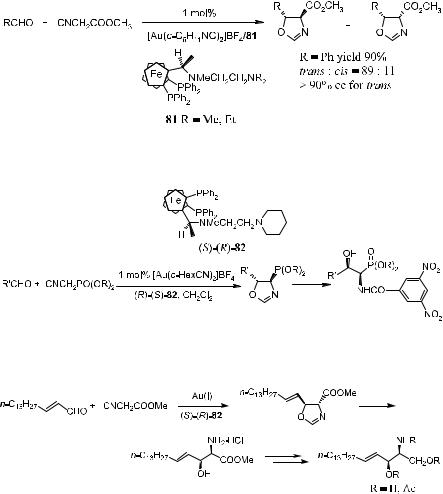
160 ALDOL AND RELATED REACTIONS
Scheme 3±28
Scheme 3±29
Scheme 3±30. Gold(I) complex±catalyzed asymmetric aldol reactions.
presence of 1 mol% of chiral aminoalkylferrocenylphosphine gold(I) (L ˆ 85) catalyst proceeds with high enantioselectivity, giving the corresponding oxazolines 83 in up to 90% ee. This compound can be further converted to optically active a-alkyl-b-hydroxyaspartic acid derivative 84 (Scheme 3±31).54
3.4.3Asymmetric Aldol Reactions Catalyzed by Chiral Lewis Acids
The aldol reaction between enolsilanes and aldehydes mediated by chiral Lewis acids may be considered the most notable achievement in the area of asymmetric aldol reactions. However, the design of new catalyst systems to tolerate
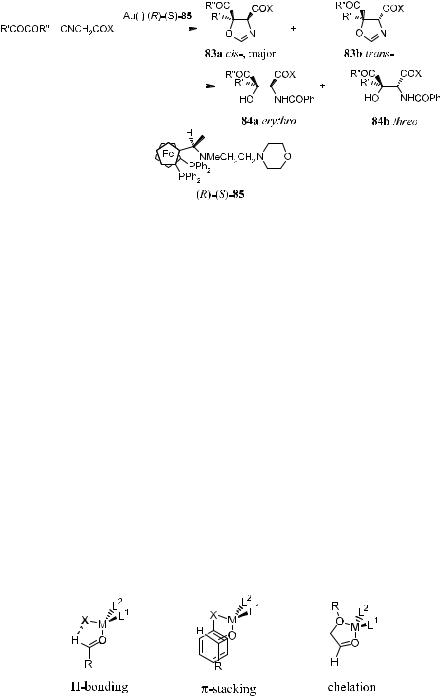
3.4 CHIRAL CATALYST-CONTROLLED ASYMMETRIC ALDOL REACTION |
161 |
|||||||
|
|
|
|
|
|
|
|
|
|
|
|
|
|
|
|
|
|
|
|
|
|
|
|
|
|
|
|
|
|
|
|
|
|
|
|
Scheme 3±31
substantial variation in both nucleophilic and electrophilic components at low catalyst loading still remains problematic.
Realizing high enantioselectivity for the catalyzed aldol reaction necessarily relies on e¨ective channeling of the reactants through a transition state that is substantially lower in energy than other competing diastereomeric transition states. Several factors must be considered when designing the catalyst. These are (A) mode of binding of the carbonyl group to the Lewis acid; (B) the regiochemistry of complexation of the two available CbO lone pairs; and (C) establishing a ®xed diastereofacial bias, therefore directing the enol/enolate addition to one of the two carbonyl p-faces. Recent investigations have incorporated additional stabilizing interactions such as H-bonding, p-stacking, or chelation into the catalyst±aldehyde complexes to give a highly de®ned carbonyl facial di¨erentiation.55,56 Developing chiral catalysts that exhibit a strong tendency toward substrate chelation and also meet other criteria necessary for asymmetric aldol reaction is likely to be the focal point of the research (Fig. 3±5).
Evans' group has demonstrated that bidentate bis(oxazolinyl)-Cu(II) (86 and 87) and tridentate bis(oxazolinyl)pyridine-Cu(II) (88 and 89) can be used
Figure 3±5. Additional stabilizing interactions between substrate and catalyst.

162 ALDOL AND RELATED REACTIONS
as e¨ective catalysts for asymmetric Diels-Alder reactions (see Chapter 5 for asymmetric Diels-Alder reactions). They also found that these complexes gave excellent reactivity in aldol reactions of Mukaiyama reagents with a series of aldehydes.57
The e½ciency of catalysts 86±89 for the asymmetric aldol reaction of a series of nucleophiles toward benzyloxyacetaldehyde was studied. For example, compound 89c was found to be an excellent catalyst for the asymmetric aldol reaction of silylketene acetal derivatives of t-butyl thioacetate, ethyl thioacetate, and ethyl acetate with benzyloxyacetaldehyde. In the presence of 0.5 mol% of the catalyst, the asymmetric aldol reaction took place at ÿ78 C in CH2Cl2, a¨ording the respective b-hydroxy esters with excellent enantioselectivity (Scheme 3±32).
Scheme 3±32. Asymmetric aldol reaction catalyzed by chiral bis(oxazolinyl)pyridine compound 89c. Reprinted with permission by Am. Chem. Soc., Ref. 57.
Catalyst 86a also catalyzed the enantioselective aldol reaction between a- keto esters and silylketene acetals or enolsilanes with high ee (ranging from 93% to 99%).58
Several other chiral Lewis acids have also been reported to e¨ect asymmetric aldol reactions. KruÈger and Carreira59 reported a catalytic aldol addition of silyl dienolate to a range of aldehydes in the presence of a bisphosphanyl± Cu(II) ¯uoride complex generated in situ from (S)-Tol-BINAP, Cu(OTf )2, and (Bu4N)Ph3SiF2. Aromatic, heteroaromatic, and a,b-unsaturated aldehydes provided the aldol adducts with up to 95% ee and 98% yield (Scheme 3±33).
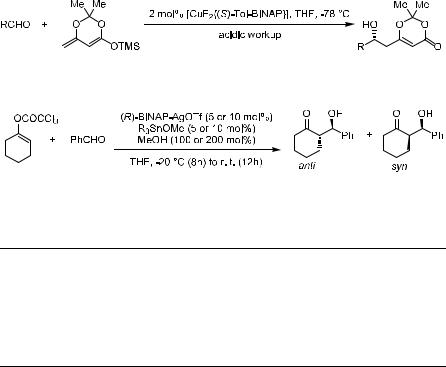
3.4 CHIRAL CATALYST-CONTROLLED ASYMMETRIC ALDOL REACTION |
163 |
Scheme 3±33
Scheme 3±34
TABLE 3±8. BINAP-Ag Complex Catalyzed Aldol Reaction
|
(R)-BINAP-AgOTf |
R3SnOMe |
MeOH |
Yield |
|
|
|
|
Entry |
(mol%) |
|
(mol%) |
(mol%) |
(%) |
anti (ee) |
syn (ee) |
|
|
|
|
|
|
|
|
|
|
1 |
10 |
10 |
(R ˆ Bu) |
100 |
62 |
84 (93) |
16 |
(18) |
2 |
10 |
10 |
(R ˆ Bu) |
200 |
94 |
92 (95) |
8 |
(16) |
3 |
5 |
5 |
(R ˆ Bu) |
200 |
82 |
92 (95) |
8 |
(17) |
4 |
5 |
5 |
(R ˆ Me) |
200 |
88 |
93 (94) |
7 |
(6) |
5 |
5 |
5 |
(R ˆ Me) |
200 |
86 |
94 (96) |
6 |
(18) |
ee ˆ Enantiomeric excess.
Reprinted with permission by Am. Chem. Soc., Ref. 61.
Besides the silyl enolate-mediated aldol reactions, organotin(IV) enolates are also versatile nucleophiles toward various aldehydes in the absence or presence of Lewis acid.60 However, this reaction requires a stoichiometric amount of the toxic trialkyl tin compound, which may limit its application. Yanagisawa et al.61 found that in the presence of one equivalent of methanol, the aldol reaction of an aldehyde with a cyclohexenol trichloroacetate proceeds readily at ÿ20 C, providing the aldol product with more than 70% yield. They thus carried out the asymmetric version of this reaction using a BINAP±silver(I) complex as chiral catalyst (Scheme 3±34). As shown in Table 3±8, the Sn(IV)- mediated aldol reaction results in a good diastereoselectivity (anti/syn ratio) and also high enantioselectivity for the major component.
3.4.4 Catalytic Asymmetric Aldol Reaction Promoted by Bimetallic Catalysts: Shibasaki's System
Most of the asymmetric aldol reactions discussed thus far deal with the nucleophilic addition of a chiral or achiral enolate onto a chiral or achiral aldehyde,
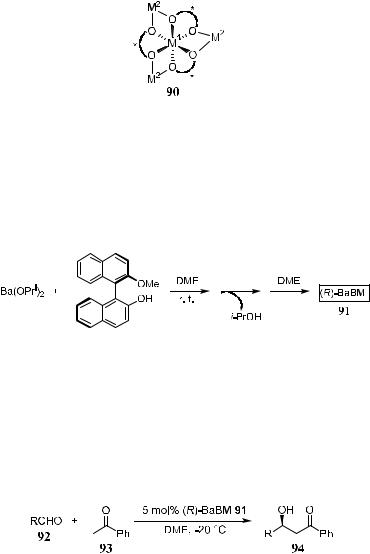
164 ALDOL AND RELATED REACTIONS
and the preparation of an enol derivative is necessary. In the course of developing direct catalytic asymmetric aldol reactions starting from aldehydes and unmodi®ed ketones without the involvement of enolate, Yamada et al.62 developed a bimetallic compound (binaphthoxide) LLB 90 from binaphthol and LaCl3. This complex has been shown to exhibit properties of both Lewis acid and base and may be considered to be an ideal catalyst for simple asymmetric aldol reactions.
The LLB catalyst system needs a rather long reaction time and the presence of excess ketone to get a reasonable yield. Yamada and Shibasaki63 found that another complex, BaBM (91), was a far superior catalyst. Complex 91 also contains a Lewis acidic center to activate and control the orientation of the aldehyde, but it has stronger Brùnsted basic properties than LLB. The preparation of BaBM is shown in Scheme 3±35.
Scheme 3±35. Preparation of BaBM 91.
Reaction of aldehydes and 2 equivalents of ketone in the presence of 5 mol% of (R)-BaBM gives good yield of aldol product (77±99%) with moderate enantioselectivity (54±70% ee) after a 2-day reaction (Scheme 3±36 and Table 3±9). Although the enantioselectivity is not very high, this is one of the ®rst examples of direct aldol condensation using barium catalyst as the promoter.
Scheme 3±36
|
3.5 |
DOUBLE ASYMMETRIC ALDOL REACTIONS 165 |
|
TABLE 3±9. Direct Aldol Reaction Promoted by 91 |
|
||
|
|
|
|
Entry |
R in 92 |
Yield for 94 (%) |
ee for 94 (%) |
|
|
|
|
1 |
t-Bu |
77 |
67 |
2 |
PhCH2(CH3)2C |
77 |
55 |
3 |
c-C6H11 |
87 |
54 |
4 |
i-C3H7 |
91 |
50 |
5 |
BnOCH2(CH3)2C |
83 |
69 |
6 |
BnO(CH3)2C |
99 |
70 |
ee ˆ Enantiomeric excess.
Reprinted with permission by Pergamon-Elsevier Science Ltd., Ref. 63.
This catalyst can also be applied in the reaction of aldehydes bearing a bulky a-group, and moderate to good yields can be obtained. The advantage of this reagent, bearing both Lewis acidic and Lewis basic properties, are further discussed in Chapter 8.
3.5DOUBLE ASYMMETRIC ALDOL REACTIONS
As shown in Scheme 3±37, reaction of (ÿ)-96 with achiral (Z)-O-enolate 95 provides a mixture of 97 and 98 in an approximate ratio of 3:2.64 After screening a variety of chiral enolate reagents, (S)-100c has been found to provide good asymmetric induction. Aldol reaction of achiral aldehyde 99 with (S)-100c (the most stereoselective boron enolate among the three compounds 100a±c; see Table 3±10) provides a mixture of diastereoisomers 101 and 102 in a ratio of 100:1.65 Successive treatment of a mixture of 101/102 with hydrogen ¯uoride followed by oxidation with sodium metaperiodate provides the corresponding 2,3-syn-3-hydroxy-2-methylcarboxylic acid 103 with an enantiomeric excess of over 98%. This three-step process is now referred to as the threecarbon atom extension.
Now, we examine the interaction of chiral aldehyde (ÿ)-96 with chiral enolate (S)-100b. This aldol reaction gives 104 and 105 in a ratio of 104:105 > 100:1. Changing the chirality of the enolate reverses the result: Compound 104 and 105 are synthesized in a ratio of 1:30 (Scheme 3±38).66 The two reactions (ÿ)-96 ‡ (S)-100b and (ÿ)-96 ‡ (R)-100b are referred to as the matched and mismatched pairs, respectively. Even in the mismatched pair, stereoselectivity is still acceptable for synthetic purposes. Not only is the stereochemical course of the aldol reaction fully under control, but also the power of double asymmetric induction is clearly illustrated.
Scheme 3±39 shows the reaction of boron enolates 106 and 108 with chiral aldehydes …2R,4S†- and …2S,4R†-96. In the matched case, lactone 3,4-anti-107 is obtained with very high ee.67
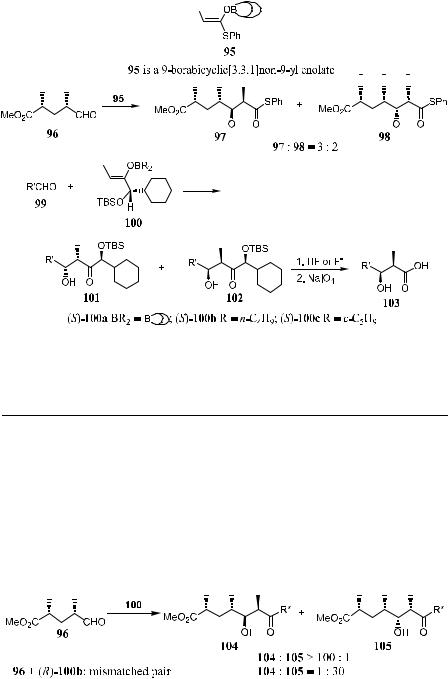
166 ALDOL AND RELATED REACTIONS
Scheme 3±37
TABLE 3±10. Reaction of Aldehydes with Boron Enolates
Aldehyde |
R0 |
Boron Enolate |
98:97 |
99a |
PhCH2OCH2CH2 |
(S)-100a |
16:1 |
|
|
(S)-100b |
28:1 |
|
|
(S)-100c |
100:1 |
99b |
(CH3)2CH |
(S)-100a |
>100:1 |
|
|
(S)-100b |
>100:1 |
|
|
(S)-100c |
No reaction |
|
|
|
|


 S
S









Scheme 3±38
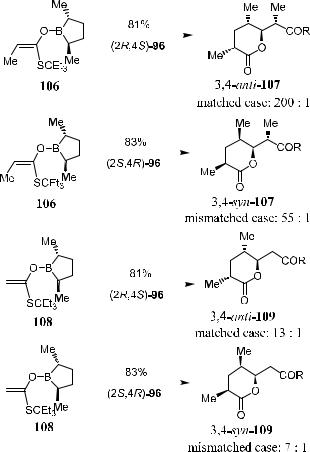
|
|
3.6 ASYMMETRIC ALLYLATION REACTIONS |
167 |
||||||||||||||
|
|
|
|
|
|
|
|
|
|
|
|
|
|
|
|
|
|
|
|
|
|
|
|
|
|
|
|
|
|
|
|
|
|
|
|
|
|
|
|
|
|
|
|
|
|
|
|
|
|
|
|
|
|
|
|
|
|
|
|
|
|
|
|
|
|
|
|
|
|
|
|
|
|
|
|
|
|
|
|
|
|
|
|
|
|
|
|
|
|
|
|
|
|
|
|
|
|
|
|
|
|
|
|
|
|
|
|
|
|
|
|
|
|
|
|
|
|
|
|
|
|
|
|
|
|
|
|
|
|
|
|
|
|
|
|
|
|
|
|
|
|
|
|
|
|
|
|
|
|
|
|
|
|
|
|
|
|
|
|
|
|
|
|
|
|
|
|
|
|
|
|
|
|
|
|
|
|
|
|
|
|
|
|
|
|
|
|
|
|
|
|
|
|
|
|
|
|
|
|
|
|
|
|
|
|
|
|
|
|
|
|
|
|
|
|
|
|
|
|
|
|
|
|
|
|
|
|
|
|
|
|
|
|
|
|
|
|
|
|
|
|
|
|
|
|
|
|
|
|
|
|
|
|
|
|
|
|
|
|
|
|
|
|
|
|
|
|
|
|
|
|
|
|
|
|
|
|
|
|
|
|
|
|
|
|
|
|
Scheme 3±39
3.6ASYMMETRIC ALLYLATION REACTIONS
Given the fact that homoallyl alcohols can be easily converted to the corresponding aldol compounds, allylation of aldehydes with allylic and crotyl organometallic reagents is synthetically analogous to the aldol addition of metal enolates. This reaction has signi®cant advantages over aldol condensations because the produced alkenes may not only be readily converted into aldehydes but also undergo a facile one-carbon homologation to d-lactones via hydroformylation or be selectively epoxidized to introduce a third chiral center.
As a result, allylic organometallic reactions have attracted much attention, and the allylation or crotylation reactions via the corresponding organometallic compounds have been extensively studied. This method has become one of the
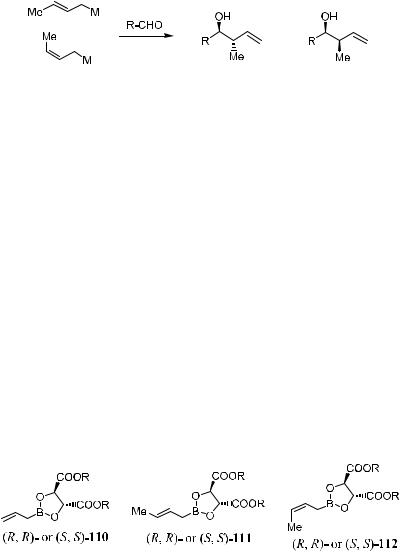
168 ALDOL AND RELATED REACTIONS
most useful procedures for controlling the stereochemistry in acyclic systems. Except for allyl silanes, most of the allylic organometallic or organometalloid systems are reactive enough toward aldehyde carbonyl groups, even if Lewis acid is not applied.
The general synthetic equation can be expressed by Eq. 3±1. ``M'' represents various metals. These conversions generate two new stereocenters and four possible diastereomeric products. The product syn/anti ratio re¯ects the (Z):(E ) ratio in the crotyl moiety, which may include B-, Al-, Sn-, Si-, or Ti-based reagents.
(3±1)
where M ˆ SiMe3; SnBu3; BR2; AlR2; MgX; Li; CrX2; TiCp2X; ZrCp2X, and so forth.
Before the late 1970s, allylic organometallic compounds were studied primarily by a limited number of organometallic chemists who were interested only in the structural determination of metal-allyl species. A number of studies on the reactions of metal-allyl with electrophiles have focused solely on the regioselectivity of the allylic unit. In the late 1970s, signi®cant synthetic interest began to emerge in controlling the stereochemistry of C±C bond formation in reactions of metal-allyl compounds with aldehydes or ketones.
Over the past two decades, chiral allyland crotyl-boron reagents have proved to be extremely valuable in the context of acyclic stereoselection. The development of superior allyl-boron reagents, which can give enantioand diastereoselectivities approaching 100%, has become both challenging and desirable.68
3.6.1The Roush Reaction
The use of tartrates as chiral auxiliaries in asymmetric reactions of allenyl boronic acid was ®rst reported by Haruta et al.69 in 1982. However, it was not for several years that Roush et al.,70 after extensive study, achieved excellent results in the asymmetric aldol reactions induced by a new class of tartrate ester based allyl boronates.
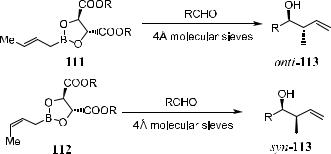
3.6 ASYMMETRIC ALLYLATION REACTIONS |
169 |
Roush ®rst reported that good yield and stereoselectivity could be obtained by reacting allyl-boronates …R,R†- or …S,S†-110 with achiral or chiral aldehydes. The auxiliary system was then extended to the (E )- and (Z)-crotyl family (Scheme 3±40) in which reagent 111 and 112 served as (E )- or (Z)-propionate enolate equivalents. Compound 111/112 can be easily prepared by modi®ed Schlosser's crotyl-boronate synthesis71 from (E )- or (Z)-butene. Synor anti113 can be obtained via the corresponding allylation reaction. Molecular sieves are used to help maximize the enantioselectivity by maintaining an anhydrous reaction condition and to prevent adventitious hydrolysis of the chiral boronic reagents to achiral allyl-boronic acid, which may lead to unselective products.
In the reaction of …R,R†-tartrate allyl-boronate with aldehydes, Si attack of the nucleophile on the carbonyl group has been observed, while Re attack occurs in …S,S†-tartrate allyl-boronate reactions. Thus, an (S)-alcohol is produced preferentially when an …R,R†-allyl reagent is used, and the (R)-product can be obtained from an …S,S†-reagent, assuming that the ``R'' substituent in the aldehyde substrate takes priority over the allyl group to be transferred. In fact, no exceptions to this generalization have yet been found in over 40 wellcharacterized cases where the tartrate auxiliary controls the stereochemical outcome of the allyl or crotyl transfer.72
The asymmetric induction cannot be explained simply by steric interaction because the R group in the aldehyde is far too remote to interact with the tartrate ester. In addition, the alkyl group present in the tartrate ligand seems to have a relatively minor e¨ect on the overall stereoselectivity. It has thus been proposed that stereoelectronic interaction may play an important role. A more likely explanation is that transition state A is favored over transition state B, in which an n±n electronic repulsion involving the aldehyde oxygen atom and the b-face ester group causes destabilization (Fig. 3±6). This description can help explain the stereo-outcome of this type of allylation reaction.
Systematic studies of the reactions of tartrate allyl-boronates with a series of chiral and achiral alkoxy-substituted aldehydes show that conformationally unrestricted a- and b-alkoxy aldehyde substrates have a signi®cant negative impact on the stereoselectivity of asymmetric allyl-boration. In contrast, con-
Scheme 3±40
